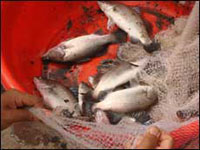 During recent years, many households have had high income by hatching of tiger prawns (penaeus monodon), but a lot of people had to go bankrupt because of shrimp ponds “overloaded” with chemicals, antibiotic and full of germs. Therefore, some of them formerly had bred tiger prawns, now they have switched to rotational breeding other aquatic products, in which, lates calcarifer is one of species which has been chosen because they shall bring high economic value.
During recent years, many households have had high income by hatching of tiger prawns (penaeus monodon), but a lot of people had to go bankrupt because of shrimp ponds “overloaded” with chemicals, antibiotic and full of germs. Therefore, some of them formerly had bred tiger prawns, now they have switched to rotational breeding other aquatic products, in which, lates calcarifer is one of species which has been chosen because they shall bring high economic value.
For Mr. Nguyen Kim Chuyen who had bred shrimps for many years in Long Huong Ward, Baria Town, the golden age of tiger prawn hatching is in the past. Mr. Chuyen said: “For more than 3 years, I had lost for every tiger prawn hatching; it did the same with litopenaeus vannamei hatching”. According to Mr. Chuyen, germs of shrimp are always in the ponds from crop to crop. Thus, if breeding shrimp continuously but there is no measure of crop rotation, it is easy to fail. Though Mr. Chuyen has used chemical and antibiotic reasonably, followed exactly the technical instruction but he met with failures constantly by epidemic diseases. To learn about the facts, Mr. Chuyen found out that he has been failed due to environmental ponds was degenerated. “Recently, thanks to the Provincial Aquaculture Extension Center has given professional advice and guided techniques, I decided to choose lates calcarifer hatching rotationally in order to improve the environment” – Mr. Chuyen said.
In the past time, many of tiger prawn ponds in the province had been empty, pursuant to the households, the more breeding the more losing. Through training courses and other media, the Provincial Aquaculture Extension Center has continuously recommended breeders should use shrimp ponds to raise other aquatic products as: unisexed tilapia, pseudapocrytes elongates, lates calcarifer… in order to overcome risks of epidemic diseases because of environmental pollution.
From the beginning of 2008, the Provincial Aquaculture Extension Center has carried out three performing places of lates calcarifer hatching models in Long Huong Ward (Baria Town); Binh Chau Commune and Phuoc Thuan Commune (Xuyen Moc District). Mr. Nguyen Dang Nhan, Vice Director of the Provincial Aquaculture Extension Center, said: “Lates Calcarifers are suitable with the environment of these areas and they have ability to bring high economic value. The most important thing is propaganda to farmers about the measure of crop rotation in order to improve the environment in tiger prawn ponds”. To this time, at the performing places, lates calcarifers which are bred have got fairly growth. Their weights are from 0.4 to 0.5kg/fish/4 months. According to Mr. Nhan, if breeding from 8 months to a year, they can weigh from 0.8 to 1 kg, with this weight they are very easy to sell. At present, on the market they can sell from 60,000 – 70,000 VND/kg. “The techniques for lates calcarifer hatching are not very difficult, the breeding and industrial foodstuff have been sold everywhere. With these advantages, crop rotation of breeding lates calcarifer in tiger prawn ponds is an appropriate solution” – Mr. Nhan considered.
However, because of acquaintance with new domestic animals so farmers and fishers can be unable to make up their minds. In the seminars at edge of rice field, many people were unaware of breeding lates calcarifer difficult or not. Formerly, there were some people who bred lates calcarifer but they did not get high effect because of using raw foodstuff which is both easy for epidemic diseases and difficult for controlling source of foodstuff. Lates calcarifers are in the habit of eating each other, so during the breeding process, if the foodstuff does not meet needs the stronger and bigger fish will eat the weaker and smaller ones. The industrial foodstuff is a solution to help breeders controlling the habit of eating one another, cutting down the rate of loss. The management of environment in the ponds of lates calcarifer is simpler than tiger prawn. For 4 months of breeding, Mr. Chuyen summarizes: “Breeding lates calcarifers has to be tackled less than tiger prawn hatching. If there are conditions, we should change water for the ponds once a week or a fortnight; the rate of changing water is about 30%. In case of having no water to change, every 10 – 15 days, depending on the age of fish we can use micro-bios with suitable quantity to deal with water”.
Source:
Source: BR-VT Newspaper
 During recent years, many households have had high income by hatching of tiger prawns (penaeus monodon), but a lot of people had to go bankrupt because of shrimp ponds “overloaded” with chemicals, antibiotic and full of germs. Therefore, some of them formerly had bred tiger prawns, now they have switched to rotational breeding other aquatic products, in which, lates calcarifer is one of species which has been chosen because they shall bring high economic value.
During recent years, many households have had high income by hatching of tiger prawns (penaeus monodon), but a lot of people had to go bankrupt because of shrimp ponds “overloaded” with chemicals, antibiotic and full of germs. Therefore, some of them formerly had bred tiger prawns, now they have switched to rotational breeding other aquatic products, in which, lates calcarifer is one of species which has been chosen because they shall bring high economic value. 
 Previous page
Previous page Back to top
Back to top







